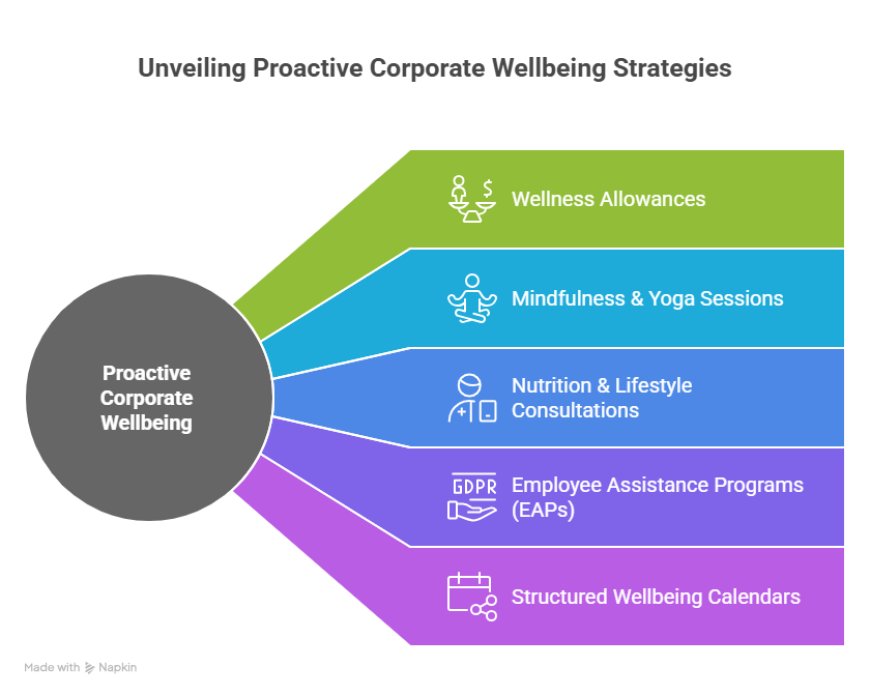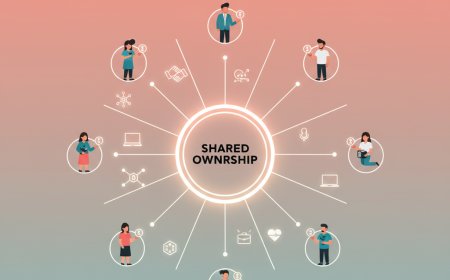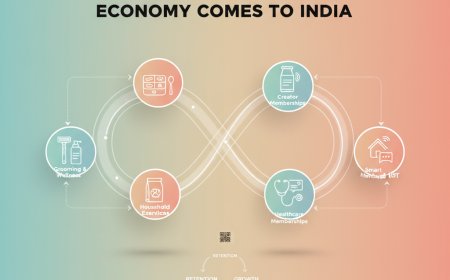The Business of Wellness Mental Health, Fitness Tech & Corporate Wellbeing
The business of wellness is evolving fast — from mental health support and fitness tech to proactive corporate wellbeing strategies. This article explores why organizations are prioritizing whole-person wellness and how the future of work is being redesigned around wellbeing.

Not too long ago, “wellness at work” meant maybe a yoga session during the annual offsite or a motivational poster in the break room. It was seen as something nice to have, not something essential. But the world has changed — and so have we.
Over the last few years, stress, burnout, and exhaustion have become everyday realities. Hybrid work blurred the lines between home and office. People found themselves “always on,” constantly balancing work calls, deadlines, and personal responsibilities — often in the same room.
As a result, well-being is no longer a side conversation. It’s at the center of how people work and how companies operate.
And here’s the big shift:
Wellness has become a $5 trillion global industry.
From meditation apps and fitness wearables to therapy platforms and workplace wellness programs — wellness is now a strategic business investment, not a perk.
Companies are realizing something simple but powerful:
Healthy, supported employees are more engaged, more creative, and more likely to stay.
So the core question isn’t “should we invest in wellness?” anymore —
It’s “how do we build work environments where people can actually thrive?”
The New Definition of Wellness
For years, “wellness” was mostly about physical health — gym memberships, step challenges, maybe a nutrition workshop. But today, the picture is much broader and more holistic.
People now see wellness as:
- Emotional health → feeling safe, respected, and understood at work.
- Mental well-being → manageable stress levels and psychological safety.
- Financial stability → less anxiety about money and long-term security.
- Social connection → a sense of belonging and healthy workplace relationships.
In other words:
Wellness is no longer just about our bodies. It’s about our whole lives.
This is what many call “whole-person wellness.” And it directly impacts how people show up at work.
When employees feel supported — emotionally, mentally, and socially — performance naturally improves. They collaborate better, solve problems faster, and stay longer with the company.
And here’s the key:
Employees are not just asking for wellness support — they now expect it.
Today’s workforce, especially younger generations, wants:
- Flexibility and meaningful work
- Respect for mental health
- Workplaces that care, not just measure output
This is why wellness has become core to company culture.
It’s not about adding perks.
It’s about rebuilding workplaces to support real human well-being.
The Mental Health Movement
Just a few years ago, talking about mental health at work felt uncomfortable — even risky. But the pandemic changed everything. When the world slowed down, people were forced to sit with their thoughts, routines, anxieties, and emotional exhaustion. And suddenly, conversations about mental well-being became normal — even necessary.
Today, mental health is recognized as a core part of workplace performance — not a personal issue to be dealt with alone.
We’ve seen:
- A rise in therapy and counseling platforms
Tools like InnerHour, Wysa, MindPeers, Amaha are making mental health support more accessible and less intimidating. - Mindfulness and meditation apps go mainstream
Apps like Headspace and Calm aren’t just for individuals anymore — companies are offering them to employees as wellness benefits. - Workplace Policies Are Evolving
- Stress leave and burnout recovery leave are now part of HR handbooks.
- Teams are being trained in psychological safety — creating workplaces where people can ask for help without fear.
- Leaders are being coached to spot emotional fatigue before it turns into attrition.
The key shift?
Mental health is now seen as a workplace KPI — something that directly influences productivity, creativity, and retention.
Companies aren’t asking:
“Do employees have mental health issues?”
They’re asking:
“How can we build systems that keep people mentally well?”
The Rise of Fitness Tech & Bio-Tracking
Wellness today is also becoming data-driven.
People are no longer just guessing whether they are healthy — they’re measuring it.
Smartwatches and wearables have become everyday tools. Devices like Apple Watch, Fitbit, Garmin, Samsung Galaxy Watch, and rings like Ultrahuman Ring help track:
- Steps & calories
- Sleep quality
- Heart rate & stress levels
- Heart Rate Variability (HRV) — a key indicator of recovery
This has led to a shift from reactive health (“I don't feel well, let me fix it”) to proactive health (“I monitor myself daily to stay balanced”).
Add to this:
- Personalized coaching apps like Cure.Fit, Ultrahuman, Apple Health, Nike Training Club
These tools provide guided workouts, lifestyle insights, and habit-building nudges. - Gamification makes fitness social
Teams compete in step challenges, companies host wellness leaderboards, and individuals earn streaks that keep them motivated.
People are no longer waiting for doctors to tell them to take care of themselves — they are taking control of their well-being in real time.
Fitness tech has turned wellness into something visible, measurable, and shareable — making healthy habits easier to adopt and sustain.
Corporate Wellbeing Goes Proactive
A few years ago, employee wellbeing programs were mostly symbolic — maybe an annual yoga session or a webinar on stress. But today, companies are taking wellbeing seriously and proactively.
Why? Because burnout is real. Hybrid work blurred work-life boundaries. And employees now want more than a paycheck — they want to feel supported.

So what are companies actually doing?
· Wellness Allowances
Employees get a monthly or yearly budget they can use for gym memberships, therapy, meditation apps, sports clubs — whatever supports their well-being.
· On-Site or Virtual Mindfulness & Yoga Sessions
Regular breathing workshops, movement breaks, or guided meditation sessions are becoming workplace norms — especially in hybrid setups.
· Nutrition & Lifestyle Consultations
Companies are partnering with nutritionists so employees can receive guidance on sleep, diet, energy, and stress management.
· Employee Assistance Programs (EAPs)
Confidential counseling and mental health hotlines — available 24/7 — to help employees navigate stress, anxiety, career pressure, or personal challenges.
· Structured Wellbeing Calendars
Wellness is no longer random — companies are planning it like strategy.
The big shift: Wellness is moving from “optional benefit” to built-in, ongoing support system.
And businesses are seeing real results:
· Higher retention
· Lower burnout
· Better productivity
· Stronger trust & team culture
Many studies show that organizations that invest in wellbeing see reduced attrition and improved engagement — because people stay where they feel healthy, valued, and understood.
Why Businesses Are Investing Now
So why is this happening now — and not a decade ago?
It comes down to a few powerful forces:
1. Talent Retention & Employer Branding
In a competitive job market, how you treat your people matters.
Employees choose companies that support their well-being — and leave those that don’t.
2. Rising Healthcare Costs
Burnout, stress, and lifestyle diseases are expensive — for employees and employers.
Supporting wellness early is cheaper than paying for healthcare later.
3. A Changing Workforce
Gen Z and younger millennials openly talk about:
· Mental health
· Work-life balance
· Flexible working
· Purposeful work
They expect wellness to be part of the workplace — not an afterthought.
4. Wellness = Competitive Advantage
Companies known for caring about their people attract:
· Better talent
· More engaged teams
· Stronger performance
Today, wellness is strategy — not charity.
Businesses invest in wellness because wellness drives performance.
The Industry Players to Watch
The business of wellness is no longer just gyms and meditation classes — it’s becoming a full-scale services industry, powered by tech, psychology, data, and design. A new wave of wellness companies is shaping how individuals and organizations approach wellbeing.
Rising Startups
These young companies are bridging science and lifestyle:
· Ultrahuman – Focuses on metabolism and sleep optimization with wearables like the CGM-based “Cyborg” patch.
· Cure.Fit (Cult.Fit) – Gym classes, home workouts, nutrition, and mental well-being — all in one platform.
· Wysa – An AI-driven mental health chatbot that helps users cope with stress, anxiety, and emotional challenges.
· Mindhouse (now Shyft) – Offers yoga therapy, breathing practices, and guided relaxation for daily stress support.
These startups speak the language of modern users: convenience, personalization, and habit-building.
Global Platforms
These brands helped make wellness mainstream and digital:
· Headspace – Meditation made simple, friendly, and accessible.
· Calm – Sleep stories, soothing sounds, and guided mindfulness.
· Peloton – Fitness-as-a-community via connected workouts.
· WHOOP – A performance wearable dedicated to recovery, not just activity.
They turned wellness into something you do daily, not once in a while.
Enterprise Wellness Service Providers
Workplace wellbeing is becoming a specialized service category:
· BetterUp – Coaching for leadership development and resilience.
· Modern Health – End-to-end mental wellness care — from self-guided courses to therapy.
These providers are helping organizations build structured, measurable well-being programs — not just activities, but real support systems.
The takeaway: Wellness has evolved into a professional, tech-enabled ecosystem with solutions for individuals, teams, and entire organizations.
Roadblocks & Real Challenges
Even though wellness is booming, the journey isn’t smooth.
1. Wellness Fatigue is Real
Many people feel overloaded:
· Too many apps
· Too many nudges
· Too many “wellness activities” that feel forced
Wellness can’t be another to-do list item.
2. One-Size-Fits-All Doesn’t Work
A yoga session won’t help someone dealing with:
· Financial stress
· Care responsibilities
· Anxiety
· Chronic health issues
Wellness needs to be personalized, not generic.
3. Privacy Matters
With wearables and trackers, employees may worry:
· Who sees my health data?
· Will it affect my appraisals or opportunities?
Trust is essential. Transparency is non-negotiable.
4. Benefits Alone Don’t Fix Culture
A company can offer meditation apps and therapy access —
but if managers still glorify overwork, nothing changes.
True wellbeing requires:
· Healthy work expectations
· Supportive leadership
· Psychological safety
· Real work-life boundaries
Wellness must be built into the culture, not layered on top.
The Future: Workplaces Designed for Human Wellbeing
The future of work isn’t just about productivity — it’s about people thriving.
Workplaces are shifting from being places where we show up to places where we feel supported, energized, and connected.
What the next phase looks like:
· Hybrid routines that respect personal rhythms — not “always online” work.
· Office spaces designed for collaboration, not just desks.
· Wellbeing programs that are personalized — not one-size-fits-all.
· Leaders trained in empathy, conflict resolution, and emotional intelligence.
· Technology that supports wellness — instead of overwhelming employees.
We’re moving towards organizations where:
· Mental health is openly discussed,
· Boundaries are respected,
· Recovery and rest are valued,
· Wellness is part of business strategy — not an HR checkbox.
The future belongs to companies that understand:
Healthy employees aren’t a cost — they’re the competitive advantage.
Wrap-Up
The Business of Wellness is no longer an optional perk — it’s a strategic priority.
· Employees today want workplaces that care about their whole selves.
· Leaders are realizing that wellbeing drives performance, creativity, and loyalty.
· Companies that invest in mental health, fitness tech, and meaningful culture support will be the ones that thrive — not just survive.
Core Takeaway:
Success in the modern workplace isn’t about pushing harder —
it’s about working smarter, supporting people, and building environments where humans flourish.
Because at the heart of every high-performing organization is one simple truth:
When people feel well, they do well.
What's Your Reaction?
 Like
0
Like
0
 Dislike
0
Dislike
0
 Love
0
Love
0
 Funny
0
Funny
0
 Angry
0
Angry
0
 Sad
0
Sad
0
 Wow
0
Wow
0

























































































































































































